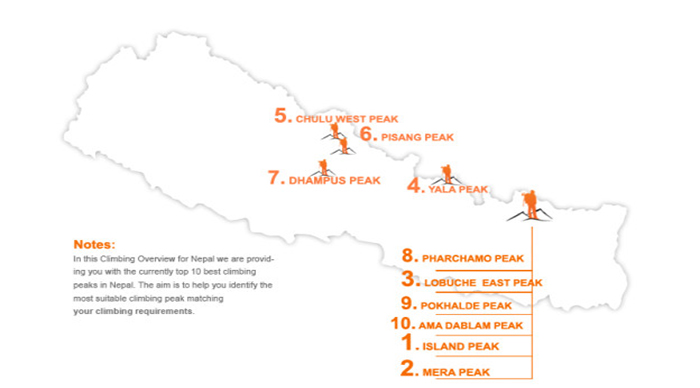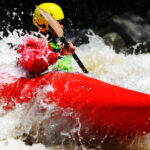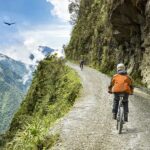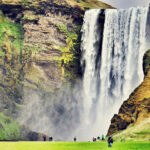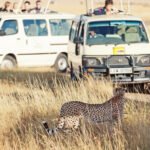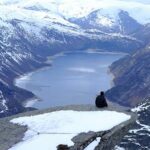So you finally decide to put your busy life on hold for a few weeks to go peak climbing in Nepal and the majestic Himalayas. However, with the myriad of peaks out there, you’re at a loss as to which peak would be suitable for you.
Then, you search online for “climbing peaks in Nepal”, which eventually leads you here. Fear not, dear reader, for here at Trekbooking, we have the inside scoop on all major peaks in Nepal and love sharing our knowledge.
The following article will provide you with a snapshot overview of the top 10 best climbing peaks in Nepal. After having read the article, you should be able to make you pick, ensuring that you select the climbing peak suiting exactly your needs!
Firstly, what is a ‘climbing peak’ in Nepal?
It is a peak under 7,000 metres that is considered easily climb-able by anyone who is physically fit, without specialized equipment or training. So, a climbing peak combines the joy of proper mountaineering with ‘relative’ ease of ascent, which is why they’re very popular among trekkers in the Himalayas (ice axes etc are still required for many of them!).
The Nepal Mountaineering Association (NMA) is responsible for classifying certain peaks as trekking peaks or group B climbing peaks.
Difficulty wise it should be noted, that the fact that a climbing peak in Nepal is classified as ‘Easy’ does not mean the trip, climb, and itinerary is very easy. It means that you still have to be rather fit, but, that you do not need to have any previous mountaineering experience.
How much does climbing cost?
Since all climbing peaks fall under the same group, group B, climbing any of them costs the same in terms of NMA fees. Basically, for up to 4 climbers, the price is $350, and $40 extra for each additional climber up to 8 climbers. For a team of 9 climbers, you need to pay $535, with $25 extra for each additional climber up to 12 climbers.
In addition to these fees, you also need to deposit $250 for garbage disposal, which will be refunded at the end of your trek.
Choosing the right climbing peak in Nepal:
The mystic Himalayas of Nepal feature a wide range of climbing peaks of varying remoteness and difficulty. There is no such thing as a one-size-fits-all climbing peak that’s suitable for everyone. Different people have different sets of skills, time and preference, which means that some research is required before choosing a peak.
In this article, we list out the top 10 best climbing peaks in Nepal with some very essential details for each peak. These details will, hopefully, enable you to identify a climbing peak, matching exactly your preferences.
If you want to read about a peak in detail, please click the link at the title of its entry. The climbing peaks are listed in the order of their popularity, with Island peak, being the most popular:
1. ISLAND PEAK

If you want to get a close-up view of Mt. Lhotse (4th highest mountain in the world), you will be hard-pressed to find a better vantage point than the top of Island Peak. A slightly technical yet challenging climb, this extremely popular trekking peak features a journey to the beautiful Solu Khumbu and Everest region. A hike via Everest Base Camp before the actual ascent is great route, as it allows for proper acclimatization. All in all, definitely the climbing adventure of a lifetime! Island peak is well suited for first time climbers.
Island Peak Facts:
- Number of climbers in 2013: 2,688 climbers / 505 Permits issued
- Location: Everest / Solu Khumbu region
- Altitude: 6,189 m
- Difficulty: Little Difficulty, PD (per the: French Adjectival System, IFAS)
- Number of climbing days: 1-2 (including Island peak base camp)
- Best Season: April-May, October-November
- Accommodation: Guesthouses & Lodges to Island peak or Camping / Camping at Island peak Base Camp
- Duration: 16 days and above, pending itinerary
⇒ COMPARE PRICES FOR ISLAND PEAK
2. MERA PEAK
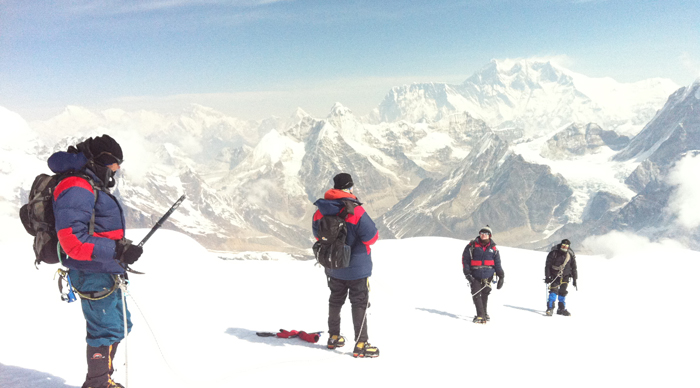
Famous as Nepal’s highest trekking peak (6,476 m), Mera is actually a collection of three separate peaks in the Solu Khumbu region. The journey to the peak, passing through lush rhododendron forests and mystic Himalayan villages, is as magnificent as the climb itself. However, nothing beats the view from Mera peak, with three of the highest mountains on Earth — Cho Oyu (8,201m), Lhotse (8,516m), and Everest (8,848m) — seemingly in your backyard! Mera peak is less accessible than Island peak and the route to the mountain therefore gives a slightly more expedition kind of feeling. The climb is less technical than Island peak. But, ice axes, ropes etc will still be used.
Mera Peak Facts:
- Number of climbers in 2013: 1,373 climbers / 264 Climbing permits issued
- Location: Makalu Barun National Park
- Altitude: 6,476 m
- Difficulty: Little Difficulty, PD (per the: French Adjectival System, IFAS)
- Number of climbing days: 3
- Best Season: September, October, November (but March/April/May are also fine months!)
- Accommodation: Lodges and Camping to Mera Peak / Camping during the 3 days climbing
- Duration: from 16 days and above, pending itinerary
⇒ COMPARE PRICES FOR MERA PEAK
Another great peak in the Solu Khumbu and Everest region, Lobuche East Peak features astoundingly close views of the surrounding Everest, Lhotse, Nuptse, Ama Dablam, Cholatse and Pumori. On the way to Lobuche base camp, you will likely pass by the infamous view point Kala Patthar (5,545 m) and Everest base camp (5,363). The climb is moderately challenging, but does not require any specialized training or experience. On the other hand, Lobuche West Peak is a difficult expedition peak.
Lobuche East Peak Facts:
- Number of climbers in 2013: 596 climbers / 118 Climbing permits issued
- Location: Everest / Solu Khumbu region
- Altitude: 6,119 m
- Difficulty: Easy, F (per the: French Adjectival System, IFAS)
- Number of climbing days: 3
- Best Season: Mid-March to May and October to Mid- December
- Accommodation: Lodges and Camping to Lobuche East Peak / Camping on Lobuche peak
- Duration: from 14 days and above, pending itinerary
⇒ COMPARE PRICES FOR LOBUCHE EAST PEAK
4. YALA PEAK
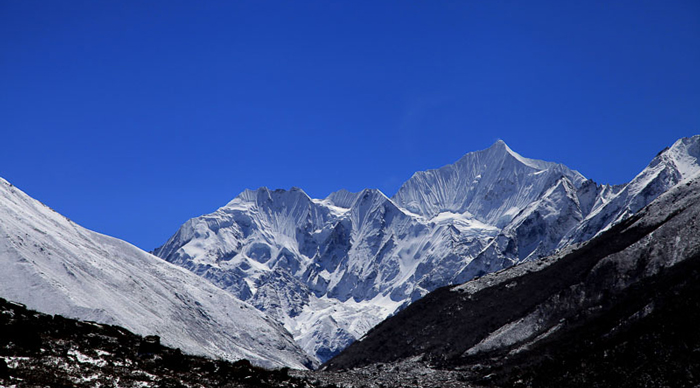
A magnificent peak in the Langtang region of Nepal, Yala peak is a non-technical peak offering excellent views of Shishapangma (8,013 m) — the highest mountain in Tibet. Other visible peaks are Langtang Lirung, Langsisha Ri, Gangchepo, and Dorche Pakpa. An excellent choice for your first Himalayan climb, especially if you are already keen on exploring the cultural and Tibetan influenced Langtang region.
Yala Peak Facts:
- Number of climbers in 2013: Not available
- Location: Langtang region
- Altitude: 5,520 m
- Difficulty: Easy, F (applied the: French Adjectival System, IFAS)
- Number of climbing days: 1
- Best Season: March – May and October – November
- Accommodation: Guesthouses & Lodges
- Duration: from 10 days and above, including trekking in the Langtang area
⇒ COMPARE PRICES FOR YALA PEAK
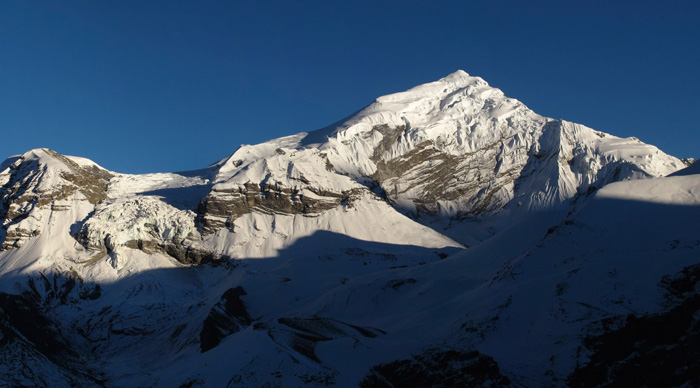
Chulu West is a peak in the Annapurna region of Nepal. It features mesmerizing views of the nearby Dhaulagiri and Annapurna I (Annapurna I has the highest death to summit rate at the moment). Chulu East Peak is another option that you ought to consider.
Although Chulu West requires some basic skills with ice axes and crampons, the experience of conquering a tough peak and the view from the top are definitely worth the effort. If you are looking for an adventure, it is a great addition to the Annapurna Circuit trek!
Chulu West Peak Facts:
- Number of climbers in 2013: Not available
- Location: Annapurna region
- Altitude: 6,419 m
- Difficulty: Little Difficulty, PD (applied the: French Adjectival System, IFAS)
- Number of climbing days: 6
- Best Season: October/November and March/April
- Accommodation: Lodges and Camping
- Duration: possible from 18 days, including trekking in the the Annapurna Circuit area and crossing the infamous Thorong La Pass
⇒ COMPARE PRICES FOR CHULU WEST PEAK
6. PISANG PEAK
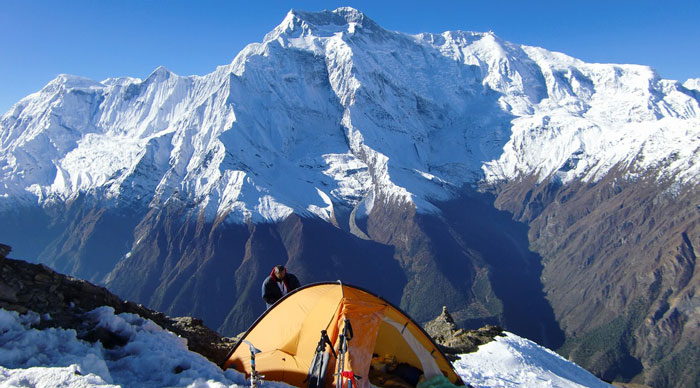
Shouldering above the Pisang village in Annapurna Conservation Area, Pisang peak is one of the most popular trekking peaks in the Annapurna region. This peak is relatively more technical than other trekking peaks. Hence, you do need to be physically fit and preferably have some previous mountaineering experience. The view from the top – majestic views of the entire Annapurna range — makes it all worth it. Crossing Thorong La pass, the widest pass in the world, after the descent is another highlight of the this climbing trip.
Pisang Peak Facts:
- Number of climbers in 2013: Not available
- Location: Annapurna region
- Altitude: 6,092 m
- Difficulty: Little Difficulty, PD (applied the: French Adjectival System, IFAS)
- Number of climbing days: 2
- Best Season: March-April and September-November
- Accommodation: Lodges and Camping / Camping during the climb
- Duration: possible from 13 days, and if wanting to do Annapurna Circuit as well, around 18 days in total
7. DHAMPUS PEAK
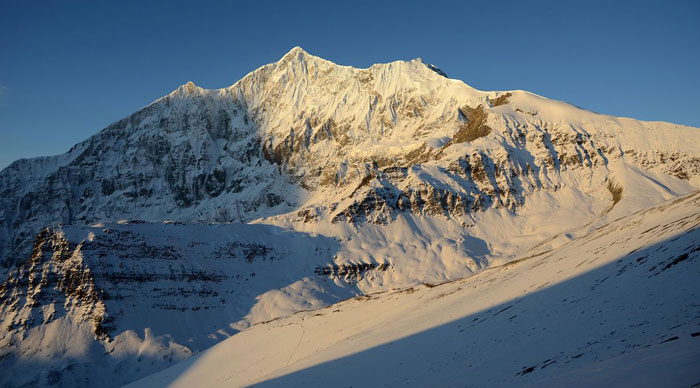
Dhampus peak lies in the Dhaulagiri massif, nestled among a host of Himalayan peaks. The Dhampus summit features a majestic panorama of as many as 30 peaks, among them giants like Machhapuchchhre, Annapurna I, and Manaslu. The spectacular view of the nearby Dhaulagiri and Tukuche will leave you in sheer awe.
Dhampus Peak Facts:
- Number of climbers in 2013: Not available
- Location: Dhaulagiri area (close to the Annapurna Region)
- Altitude: 6,012 m
- Difficulty: Little Difficulty, PD (per the: French Adjectival System, IFAS)
- Number of climbing days: 2
- Best Season: Mar-Apr and Oct-Nov
- Accommodation: Lodges and Camping
- Duration: from 15 days and above, pending itinerary
⇒ COMPARE PRICES FOR DHAMPUS PEAK
8. PHARCHAMO PEAK
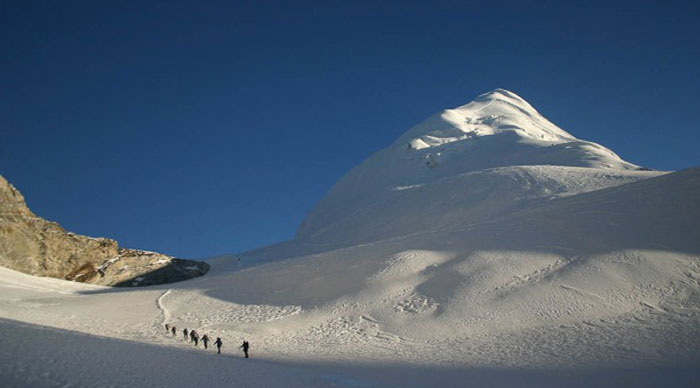
Frequently climbed in conjunction with Ramdung — another excellent peak in the Rolwaling valley — Pharchamo is a snowy peak that offers a pleasant and not particularly difficult climb. The peak lies to the south of the glacier-rich Tashi Lapcha pass (5,760 m) that connects Rolwaling with Khumbu valley.
Pharchamo Peak Facts:
- Number of climbers in 2013: Not available
- Location: Gaurishankar Conservation Area
- Height: 6,187 m
- Difficulty: Easy, F (per the: French Adjectival System, IFAS)
- Number of climbing days: 1
- Best Season: Mar-Apr and Oct-Nov
- Accommodation: Lodges and Camping
- Duration: from 15 days and above, pending itinerary
9. POKHALDE PEAK
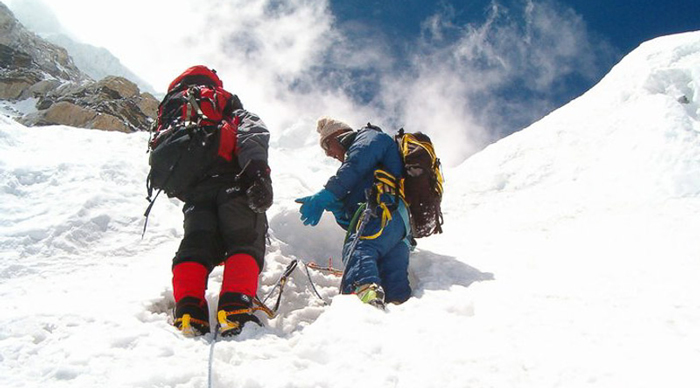
One of the easiest trekking peaks in Nepal, Pokhalde is the perfect choice for people who want a full Himalayan experience without having to exert themselves too much. It is located 12 km southwest of Mt. Everest. Despite the ease of ascent, the peak is a great vantage point to admire the surrounding Himalayas. Also, if you are already looking to explore the Everest Base Camp, why not add small climbing adventure to the itinerary?
Pokhalde Peak Facts:
- Number of climbers in 2013: Not available
- Location: Everest / Solu Khumbu region
- Altitude: 5,806 m
- Difficulty: Easy, F (per the: French Adjectival System, IFAS)
- Number of climbing days: 1
- Best Season: April-May and September-October
- Accommodation: Lodges and Camping
- Duration: from 14 days and above, pending itinerary
10. MT. AMA DABLAM
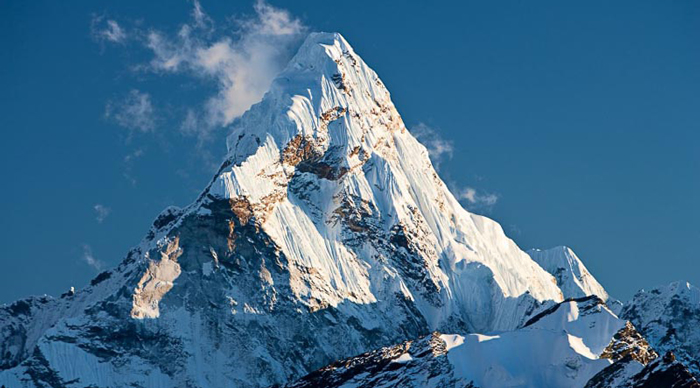
Mt. Ama Dablam is not a climbing peak but a full-on expedition peak. We have included this peak as it is a very popular expedition peak in Nepal. Popularly referred to as the ‘Matterhorn of the Himalayas’, Ama Dablam offers everything from snowy slopes and ice cliffs to gentle climbs with some great views of the numerous Khumbu villages below. The view from the top of the peak, with nearby giants like Everest and Lhotse clearly visible, is one of the most mesmerizing sights on Earth. Therefore, it comes as no surprise that Ama Dablam is the third most popular Himalayan peak for permitted expeditions. However, it is very difficult to climb and requires a high level of technical climbing skills.
Mt. Ama Dablam Facts:
- Number of climbers in 2013: Not available
- Location: Everest / Solu Khumbu region
- Altitude: 6,856 m
- Difficulty: Very Difficult, TD, (per the: French Adjectival System, IFAS)
- Number of climbing days: 12
- Best Season: April – May and September – October
- Accommodation: Guesthouses & Lodges enroute to Ama Dablam / Camping at Mt. Ama Dablam
- Duration: from 28-32 days, pending climbing company
We really hope the above top 10 best climbing peaks in Nepal gave a handy overview of excellent climbing peaks in Nepal, and, that it enabled you to make your final choice if finding the perfect climbing peak suiting, just you!
If you have decided for 1 of the above 10 climbing peaks please be informed that Bookmundi will provide you with 3 climbing offers which are free-of-charge and unbinding. You can simply enter you climbing details via the following Receive Climbing Offers link, and 3 qualified climbing companies will contact you shortly.
We welcome any comments you may have to the above Top 10 best climbing peaks in Nepal article. Feel free to Contact Us any time.
Wishing you an excellent climbing in Nepal experience!
